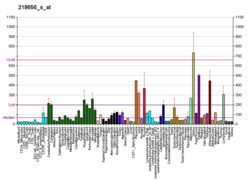Protein-coding gene in the species Homo sapiens
| LHFPL6 |
|---|
|
| Identifiers |
|---|
| Aliases | LHFPL6, LHFP, lipoma HMGIC fusion partner, LHFPL tetraspan subfamily member 6 |
|---|
| External IDs | OMIM: 606710; MGI: 1920048; HomoloGene: 4223; GeneCards: LHFPL6; OMA:LHFPL6 - orthologs |
|---|
| Gene location (Human) |
|---|
 | | Chr. | Chromosome 13 (human)[1] |
|---|
| | Band | 13q13.3-q14.11 | Start | 39,209,116 bp[1] |
|---|
| End | 39,603,528 bp[1] |
|---|
|
| Gene location (Mouse) |
|---|
 | | Chr. | Chromosome 3 (mouse)[2] |
|---|
| | Band | 3|3 C | Start | 52,948,949 bp[2] |
|---|
| End | 53,169,100 bp[2] |
|---|
|
| RNA expression pattern |
|---|
| Bgee | | Human | Mouse (ortholog) |
|---|
| Top expressed in | - vena cava
- Achilles tendon
- synovial joint
- right coronary artery
- superficial temporal artery
- saphenous vein
- tibial nerve
- cerebellar vermis
- left coronary artery
- Descending thoracic aorta
|
| | Top expressed in | - ascending aorta
- aortic valve
- molar
- endothelial cell of lymphatic vessel
- right lung
- hand
- calvaria
- right lung lobe
- body of femur
- sciatic nerve
|
| | More reference expression data |
|
|---|
| BioGPS |  | | More reference expression data |
|
|---|
|
| Orthologs |
|---|
| Species | Human | Mouse |
|---|
| Entrez | | |
|---|
| Ensembl | | |
|---|
| UniProt | | |
|---|
| RefSeq (mRNA) | | |
|---|
| RefSeq (protein) | | |
|---|
| Location (UCSC) | Chr 13: 39.21 – 39.6 Mb | Chr 3: 52.95 – 53.17 Mb |
|---|
| PubMed search | [3] | [4] |
|---|
|
| Wikidata |
| View/Edit Human | View/Edit Mouse |
|
Lipoma HMGIC fusion partner is a protein that in humans is encoded by the LHFP gene.[5][6]
This gene is a member of the lipoma HMGIC fusion partner (LHFP) gene family, which is a subset of the superfamily of tetraspan transmembrane protein encoding genes. This gene is fused to a high-mobility group gene in a translocation-associated lipoma. Mutations in another LHFP-like gene (LHFPL1, LHFPL2) result in deafness in humans and mice. Alternatively spliced transcript variants have been found; however, their full-length nature is not known.[6]
References
- ^ a b c GRCh38: Ensembl release 89: ENSG00000183722 – Ensembl, May 2017
- ^ a b c GRCm38: Ensembl release 89: ENSMUSG00000048332 – Ensembl, May 2017
- ^ "Human PubMed Reference:". National Center for Biotechnology Information, U.S. National Library of Medicine.
- ^ "Mouse PubMed Reference:". National Center for Biotechnology Information, U.S. National Library of Medicine.
- ^ Petit MM, Schoenmakers EF, Huysmans C, Geurts JM, Mandahl N, Van de Ven WJ (Aug 1999). "LHFP, a novel translocation partner gene of HMGIC in a lipoma, is a member of a new family of LHFP-like genes". Genomics. 57 (3): 438–41. doi:10.1006/geno.1999.5778. PMID 10329012.
- ^ a b "Entrez Gene: LHFP lipoma HMGIC fusion partner".
Further reading
- Kimura K, Wakamatsu A, Suzuki Y, et al. (2006). "Diversification of transcriptional modulation: Large-scale identification and characterization of putative alternative promoters of human genes". Genome Res. 16 (1): 55–65. doi:10.1101/gr.4039406. PMC 1356129. PMID 16344560.
- Longo-Guess CM, Gagnon LH, Cook SA, et al. (2005). "A missense mutation in the previously undescribed gene Tmhs underlies deafness in hurry-scurry (hscy) mice". Proc. Natl. Acad. Sci. U.S.A. 102 (22): 7894–9. Bibcode:2005PNAS..102.7894L. doi:10.1073/pnas.0500760102. PMC 1142366. PMID 15905332.
- Gerhard DS, Wagner L, Feingold EA, et al. (2004). "The Status, Quality, and Expansion of the NIH Full-Length cDNA Project: The Mammalian Gene Collection (MGC)". Genome Res. 14 (10B): 2121–7. doi:10.1101/gr.2596504. PMC 528928. PMID 15489334.
- Dunham A, Matthews LH, Burton J, et al. (2004). "The DNA sequence and analysis of human chromosome 13". Nature. 428 (6982): 522–8. Bibcode:2004Natur.428..522D. doi:10.1038/nature02379. PMC 2665288. PMID 15057823.
- Strausberg RL, Feingold EA, Grouse LH, et al. (2003). "Generation and initial analysis of more than 15,000 full-length human and mouse cDNA sequences". Proc. Natl. Acad. Sci. U.S.A. 99 (26): 16899–903. Bibcode:2002PNAS...9916899M. doi:10.1073/pnas.242603899. PMC 139241. PMID 12477932.
- Suzuki Y, Yoshitomo-Nakagawa K, Maruyama K, et al. (1997). "Construction and characterization of a full length-enriched and a 5'-end-enriched cDNA library". Gene. 200 (1–2): 149–56. doi:10.1016/S0378-1119(97)00411-3. PMID 9373149.
- Maruyama K, Sugano S (1994). "Oligo-capping: a simple method to replace the cap structure of eukaryotic mRNAs with oligoribonucleotides". Gene. 138 (1–2): 171–4. doi:10.1016/0378-1119(94)90802-8. PMID 8125298.
External links


















